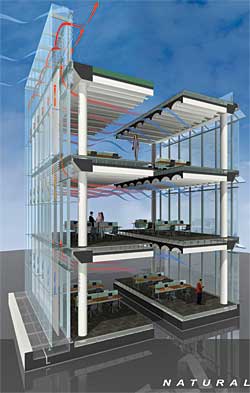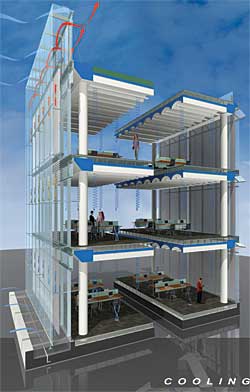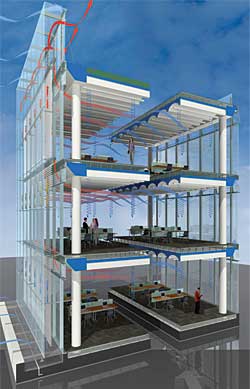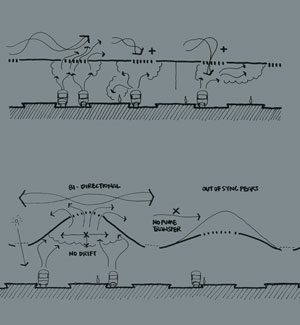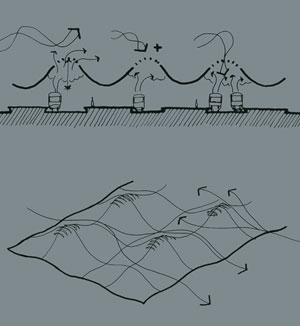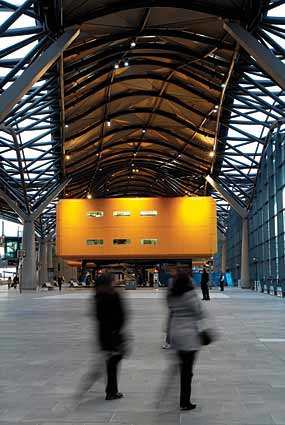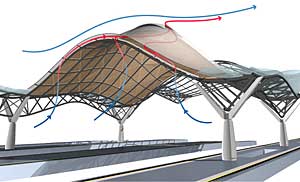Getting Aggressive About Passive Design
|
||||||
In 2004, the American Society of Heating, Refrigerating, and Air-Conditioning Engineers (ASHRAE) revised its bible of air- conditioning-Standard 55, Thermal Environmental Conditions for Human Occupancy-to account for studies that proved that when people have more control over their environment, they typically accept a wider range of temperature conditions. In 2000, one influential study led by Gail Brager at the University of California at Berkeley's Center for the Built Environment showed that traditional research in human comfort expectations neglected to adequately consider three modes of adaptation: physiological, behavioral, and psychological. While Brager did not find that physiological adaptation, or how a body adjusts to a climate over a long duration, could account for much, she did find that behavior-removing clothing, turning up fan velocities-could significantly alter environmental perceptions with occupants. Brager also found that psychologically, occupants of naturally ventilated buildings grow accustomed to less consistency in temperature, eventually coming to expect interior conditions that more closely hew to outdoor weather.
These shifts in perception undoubtedly encouraged SCB's architects to take advantage of Chicago's more temperate weather periods for natural ventilation. "A weather vane on the roof can open the facades and induce ventilation when outdoor temperatures fall within a range of 55 to 65 degrees," Patterson says, noting that the building's fullest potential lies in spring and fall. Still, he estimates that's enough time averaged across the year for the building to beat ASHRAE's 90.1 Energy Standard by 50 percent.
Green for open, red for closed
For architects and engineers, this sort of mixed-mode design probably represents the future direction of passive ventilation schemes. For risk-adverse developers, mixed-mode designs offer flexibility-tenants who prefer air-conditioning can choose to ignore the windows-as well as a buttress against the unrelenting onslaught of humidity. At NBBJ's new offices in Seattle [record, January 2007, page 110], Allan Montpellier, a mechanical engineer with the local office of Flack+Kurtz, developed a mixed-mode approach for an underfloor HVAC system that depends on occupants to operate windows when the air-conditioning is off. Green and red indicator lights, tied to the building's HVAC control system, alert staff to when they can open windows. The approach can also backfire. "If you put a desk up against a window, that person will then ‘own' that window," Montpellier says. "You really need space between desks and windows-you have to think psychologically about the space."
|
||||
But before Montpellier could get to this point, he undertook a comprehensive review of what he terms a "typical meteorological year" in Seattle. He developed a chart for NBBJ that showed the number of hours in a year when the temperature would stay in a specific range; ever the jargonists, many engineers call this "binning up" temperatures. For example, the chart indicated 432 hours annually for a bin of 60 to 62 degrees, but Montpellier mainly focuses on the values above 80 degrees. "You really start to get uncomfortable around 80 to 85 degrees, even with a ceiling fan," Montpellier says. "Above that, people will complain." He found there were only 64 working hours per year where the temperature exceeded 80 degrees, which helped convince NBBJ to go with the mixed-mode design, though he notes each client tolerates different environmental conditions.
|
|||||
Having established a case for natural ventilation, Montpellier then had to determine if he could secure enough openings in exterior walls to get the minimum amounts of air the scheme would require. The International Mechanical Code requires that for every square foot of floor area, you need 4 percent of the wall area for operable windows. Montpellier says he designs closer to 10 percent, as the code suggests a minimum that doesn't adequately address occupant comfort issues. At this point, Flack+Kurtz developed a CFD model of the building to gauge airflow patterns around and through the structure to ensure a natural ventilation scheme could accommodate the interior recesses of the building. Relatively standard design tactics-shallow, open floor plates no wider than 50 feet and a central atrium-facilitated air movement.
Engineers often refer to CFD modeling as definitive-a design tool producing results as good as the built thing. Paul Linden, chair of the department of mechanical and aerospace engineering at the University of California at San Diego, says CFD modeling can generate skewed results since most existing software, such as the widely used EnergyPlus from the Department of Energy, contains programming code that doesn't take into account internal heat gains. "EnergyPlus in its traditional form is for sealed, air-conditioned buildings," he says.
Linden, whose research has focused on airflow modeling, says updating EnergyPlus to consider natural ventilation schemes, transient environmental conditions, more complicated geometries, and estimates of comfort levels for spaces will be key to the software's usefulness in design. Still, he says he worries that many consultants don't know how to read CFD analysis results, and even worse, hardly anyone monitors buildings post-occupancy to determine the accuracy of CFD predictions. "CFD models produce nice pictures," Linden says, "but who's to say what's right or wrong."





